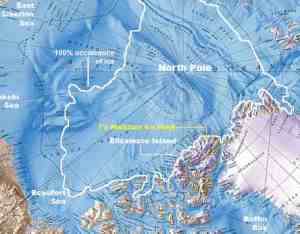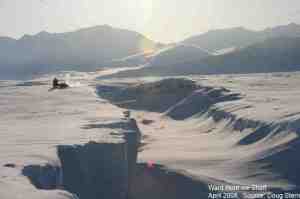UXBRIDGE, Canada , Sep 5 (IPS) – Soaring temperatures have led to the collapse of several huge ice shelves in the Canadian Arctic over the past few weeks.
One 50 sq km ice shelf on the northern coast of Canada’s Ellesmere Island simply “vanished” over three days, exposing a coast that lay buried under ice for at least 4,000 years.
At the same time, the Arctic’s thick, year-round sea ice cover has declined to near the 2007 record of 2.6 million square kilometres less ice than the summer average minimum. This year’s ice loss is still huge — an area that’s far larger than the states of Alaska and Texas combined.
“My gut feeling is that the sea ice decline won’t beat last year’s record,” said Walter Meier of the National Snow and Ice Data Center at the University of Colorado in Boulder.
This year’s sea ice decline is expected to reach its peak in the next few days. “The (2008) decline is already the second largest loss of summer ice on record even though the weather was not as warm as last year,” Meier told IPS.
What’s significant about this year’s is that it means the long-term trend of ice loss is going down much faster than expected, he said.
A summer with an ice-free Arctic is now “inevitable” and less than two decades away, Meier estimates. That doesn’t mean there won’t be any ice — on the contrary, the Arctic Ocean will be like shattered crystal on a slate floor, covered by uncountable sharp-edged icebergs and chunks of ice floating around waiting for ships or oil rigs to bump into.
 “After the final breakup of the permanent ice, it will be much more dangerous for ships because of the huge numbers of ice pieces that will be floating around,” Meier said.
“After the final breakup of the permanent ice, it will be much more dangerous for ships because of the huge numbers of ice pieces that will be floating around,” Meier said.
Some of those chunks of ice will be ice islands 50 km sq and 10 stories high just like the ones that broke off from Ellesmere Island’s ice shelves this summer, said Luke Copland, an ice expert at Canada’s University of Ottawa.
The north coast of Ellesmere Island is the Arctic’s deep freezer, where masses of thick permanent ice are found all year round. This year, and probably the first time in thousands of years, there were huge areas of open water, Copland told IPS.
“We were really surprised at how fast some of the ice shelves broke away,” he said.
Satellite images from Aug. 7 clearly showed that the 50 sq km, 30- to 50-metre thick Markham Ice Shelf was locked in a deep fjord on the Ellesmere coast as it had been for thousands of years. Clouds closed the curtain over the region until a clearing on Aug. 11 and presto — the Markham Ice Shelf had vanished.
“How could an entire ice-locked fjord become ice-free in days? I couldn’t believe it was just gone,” Copland recalled.
In total, five ice shelves of Ellesmere Island lost 23 percent of their ice — 214 sq km — during this year’s short Arctic summer.
“The ice shelf decline is far worse than our worst estimations,” he said.
 The declines are clear illustrations of the massive changes happening in the Arctic and the rapidity of this change: “I’d be surprised if there are any ice shelves left in 10 years,” Copland said.
The declines are clear illustrations of the massive changes happening in the Arctic and the rapidity of this change: “I’d be surprised if there are any ice shelves left in 10 years,” Copland said.
See full story:

